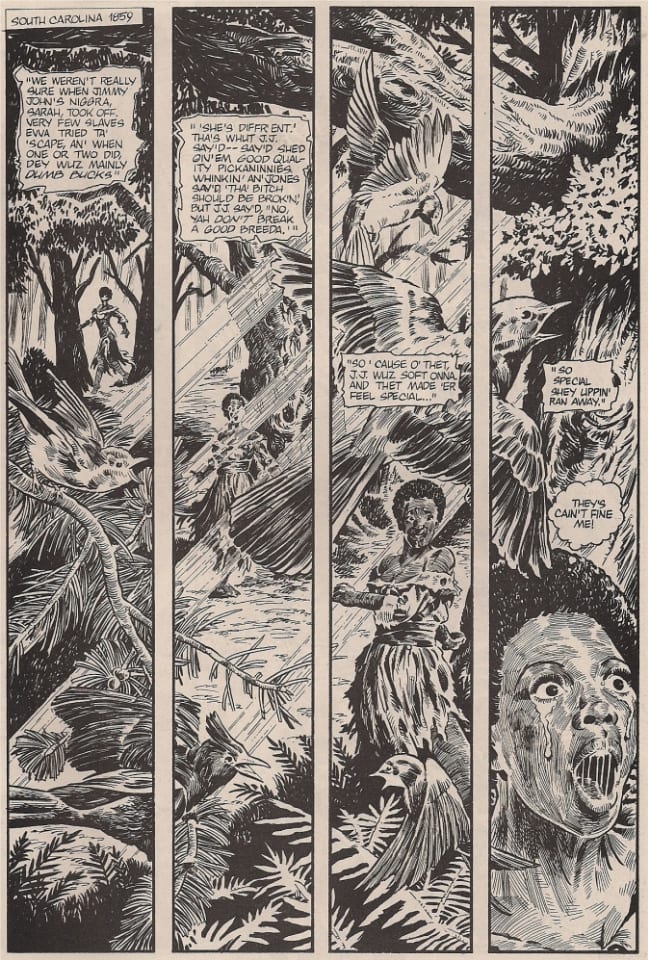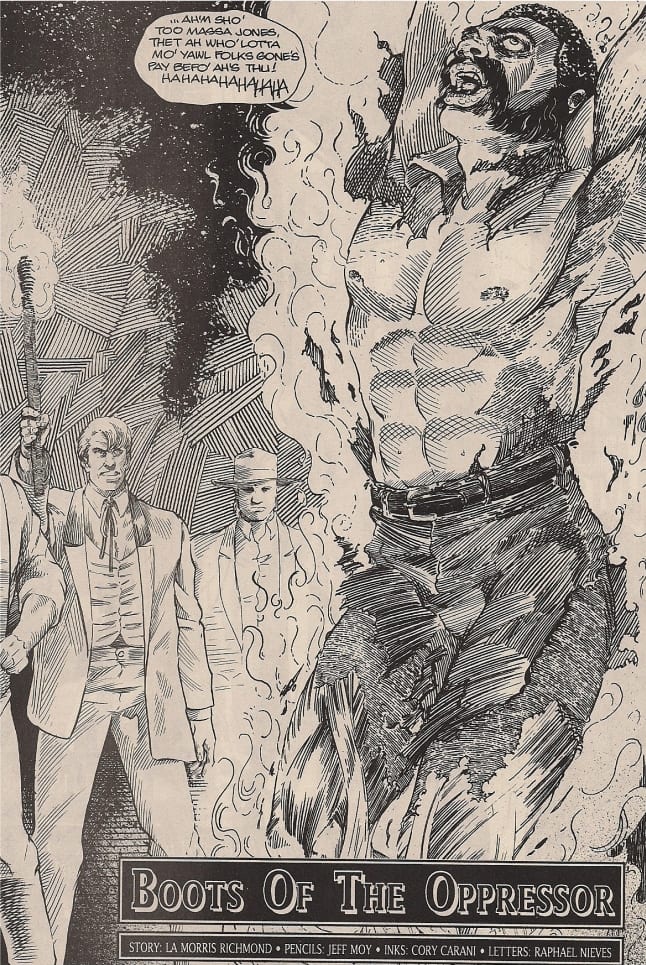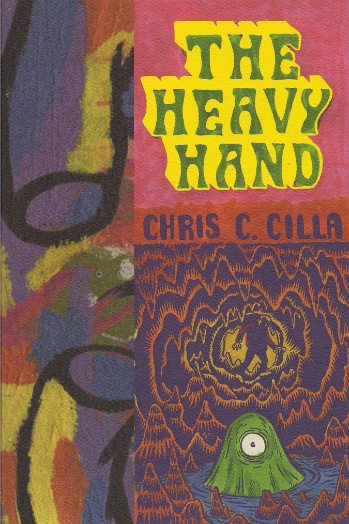As you may know, I base all of my life's decisions around comment threads on the internet, so it was with great interest that I dove into Jeet's debut column, current front-runner in the leftward sidebar's "MOST POPULAR" sweepstakes. Down a little ways in the intensedebate, reader Lunar Archivist piqued my interest with a mention of DC First Wave writer Brian Azzarello and "the controversy that occasionally follows him," insofar as, to my knowledge, controversy -- or at least some courting of the same -- was present from the very beginning of his career. And I'm not getting at his early Vertigo pieces, or even necessarily anything he wrote; I'm going all the way back to his early '90s work as an editor, and the comics that surrounded him at the horror publisher Northstar.
You would be forgiven for thinking that Northstar had gotten out of comics by that time; it will probably forever be associated with Faust, the bladed costume splatter epic from writer David Quinn and artist Tim Vigil, which had launched in 1988. By 1991 the series had moved to the creators' own Rebel Studios and Northstar had been bought out by one Andrew Rev, who'd also acquired Grendel and Elementals publisher Comico following its bankruptcy; the two entities thereafter became siblings under the penumbra of Arpad Publishing, and Northstar began diversifying production with the media license miniseries Leatherface and a new anthology comic, Splatter, launched with a cover & lead serial (Gothic Nights) drawn by Vigil and a story by Dave Cooper, whose Puke & Explode had begun at the publisher in 1990. Neither of these features were to last; by the next year Gothic Nights had joined Faust at Rebel Studios and Cooper's style -- wiggly and animated -- had given way to tighter focus on a slick sort of high-contrast b&w stylized realism.
In issue #4 of Splatter (Aug. '92), Azzarello was listed as production coordinator. By issue #5 (Nov. '92), he was managing editor, and nobody else was specified in any editorial capacity. If Azzarello was indeed in charge, such duties were solemnized by August of '93, at which time he was both credited as editor-in-chief in Splatter (and presumably all other Northstar titles) and making what looks like his professional comics writing debut in Slash, a second horror anthology, unless Azzarello was "Pablum Spriggs," whose scripting appearance in Splatter #5 occasioned an 'ooh, who is this?' notation in the issue's unsigned editorial. But even "Brian Azzarello" was shrouded in some mystery on the page; his Slash contribution was limited to "dialogue" with nobody else credited in a writing capacity -- which could suggest a desire to promote storytelling parity with the artists, or an unhappy/departed writer -- and anyway appeared only in the second printing of Slash #1 as an added bonus, with no mention of his work in the table of contents or on the cover.
As such, the story is never mentioned in online databases of Azzarello's work, kind of like how Frank Quitely is allegedly somewhere in 1997's Elementals Sex Special vol. 2 #2, even though nobody seems to be able to confirm this - actual copies are very rare, doubtlessly attributable to being the last thing Comico ever published, and also smut.
There doesn't even appear to be a proper title for Azzarello's story; a strategically positioned porno theater marquee suggests it be called Mega Mounds and the All Nighter -- Azzarello and artists Nathan Loggins & Phil Moy (recently of many kid-targeted DC comics) are listed as the movie's stars -- although I don't have the slightest idea how it might fit the plot. Mostly it's a vignette, possibly excerpted from something else, starring Klownshock, a 'wicked clown' character Northstar was attempting to sell as an entirely company-owned signature star, having observed the exit of Faust (or Matt Wagner's ultimately successful efforts at wresting the half-creator-owned Grendel away from Comico).
I've never found Klownshock to be interesting -- except for it beating Spawn to the market by a few months -- although it's worth noting the connection between the wicked clown archetype and serial killer 'fandom' of the sort that packed true crime zines, several of which were featured in the most consistently satisfying addition of Azzarello's editorship of the Northstar line: an unsigned "Hype File" dedicated to wrangling all the latest metal EPs and self-published shock pamphlets and relevant works of cinema like the immortal Tetsuo: The Iron Man. There was no word on Insane Clown Posse, which formed under that name in '92, although there's a long and engrossing article to be written on how the enduring visibility of ICP (and perhaps the simple passage of time) burned off the very 'nerdy' subcultual aspects of their own wicked clown personae and transformed them into some miscellaneous white trash catch-all for nerdy types today to leer at online.
So anyway, Klownshock is this clown who kills people, but in this episode he kills a multi-ethnic coalition of street toughs that primarily serve to evoke 'crime' or 'injustice' in the abstract, so that a black drug dealer cites Reaganomics to a teary-eyed pre-adolescent girl he's trying to extort a blowjob from, after which his white neo-Nazi friends arrive to aid him in a struggle against the intervening Klownshock. The point isn't to make sense as criminal activity, it's to pile up socio-political ills in a manner that, classically, makes the obviously insane, murderous clown obviously appear to be the only sensible actor. Many of the horror shorts in Splatter and Slash adopted this tongue-in-cheek approach, if for no readily discernible reason other than to eagerly underline the anxieties subsumed in horror fiction and thus welcome the alerted and entertained reader into the fandom club.
That said, there were other, more memorable features in the Northstar anthologies. Mostly when I think about these series I think of a three-part series that ran from issues #3 through #5 of Splatter, and quickly thereafter getting the unprecedented-for-the-publisher honor of collection into its own one-shot comic book. I'm thinking of Boots of the Oppressor, from writer La Morris Richmond, who later joked (in the collected edition) that, regarding the first chapter, "[s]omeone even wanted to print my picture with the comic to show readers that I am African American, perhaps to give the more aggressive types a target. (Thanks guys.)" It was a considerably different kind of comic for Northstar, concerning an escaped slave in 1859 North Carolina who is captured by her owner, raped by his acquaintances in the community, skinned, and finally made into a fine pair of boots, which in the good folk tale tradition then have a magical effect on those who put them on.
"And you thought Rodney King had it rough!" barked the back cover solicitation of issue #3, but it wasn't all chuckles for the staff; an (unsigned as usual) editorial inside devotes no less than six paragraphs to explaining the context of the story, with quotes from its writer, so as to head off any potential misunderstanding.
The artists assigned was also noticeably fitting: Dave & Dan Day, the latter perhaps better known today as primary penciller on Doug Moench's mid-'80s Eclipse series Aztec Ace -- or as fill-in penciller on Alan Moore's first-ever North American comic book, The Saga of the Swamp Thing #20 -- though at the time he was most visible for Cases of Sherlock Holmes, a series of adaptations initially published by Renegade, then picked up by the pre-Andrew Rev Northstar starting with issue #16. The Days could do a convincing period style, with a type of faux-engraving look, and so they were well-suited to Richmond's ferocious, angry script, which you'll notice presents its dialogue in a thick accent while the fleeing heroine seems to press up against prison bars used to 'frame' the opening splash into panels. Richmond also deliberately has the heroine (and indeed all black characters) referred to in animal terms -- "dumb bucks," "bitch," etc. -- which charges more specified, recognizable terms like "niggra" or "pickaninnies" with a dehumanizing connotation potentially forgotten in studying the period. Hence, the woman must be "brok'n."
It's an effective chapter, covering the entire creation of the titular boots -- a human into property -- betrayed only by the Day's tendency to sacrifice tactility for decoration, bordering panels with ornate facial close-ups as the skinning itself doesn't particularly connect as characters making contact with one another, a common pitfall of heavily realistic comic art.
The Days were gone by issue #4 -- this was where Azzarello first appeared in any capacity, so that the development of Boots of the Oppressor almost follows the development of his role at the publisher -- replaced by Andrew Pepoy, who'd eventually become a hugely prolific inker with several writing credits at Archie. Richmond implies in the collected edition that the artist switch was sudden ("thanks for stepping in at the last minute, buddy"), and indeed Pepoy's work seems rushed and not at all of a piece with the Days'. By this point, though, the story is also entering into more traditional routines, to act as Richmond hoped: "a tight little horror story that would, hopefully, scare the bejesus out of people." It searches for lurid scenarios as the slave owner is possessed by the power of his boots to kill the participants in the heroine's death; one is pitchforked in bed during sex, while the lady of the house, revealed in part three to be enjoying the favors of several male slaves, is flung down a flight of steps. The boots have also turned the slave owner into a black man, rousing the fears of a community that might view some humans as animals, but lives in evident fear of an uprising.
This is the final page, a return of sorts to the Days' style by Jeff Moy & Cory Carani; the former is the twin brother of Phil Moy, inker of managing editor Azzarello's writing debut, and likewise set to eventually work on DC superhero comics. This was far away from that, though not disconnected from popular culture; Boots of the Oppressor isn't as metal as other Northstar offerings of the day, but it evokes a gnarlier socially-informed horror, that of grindhouse shockers like Fight for Your Life, an older and more ground-level genre product that survives, I think, in a more potent form than the wicked clowns that scream of their era.
But it was a start, as are all continuities for someone. Northstar ceased publishing comics in 1995. After that (or maybe during it), Azzarello became a line editor at Comico, which, as mentioned above, struggled on until 1997. By that time Azzarello was contributing to new anthologies, at Vertigo, genre theme jobs like Weird War Tales and Gangland. They're also gone, as are many comics things.
***
PLEASE NOTE: What follows is not a series of capsule reviews but an annotated selection of items listed by Diamond Comic Distributors for release to comic book retailers in North America on the particular Wednesday, or, in the event of a holiday or occurrence necessitating the close of UPS in a manner that would impact deliveries, Thursday, identified in the column title above. Not every listed item will necessarily arrive at every comic book retailer, in that some items may be delayed and ordered quantities will vary. I have in all likelihood not read any of the comics listed below, in that they are not yet released as of the writing of this column, nor will I necessarily read or purchase every item identified; THIS WEEK IN COMICS! reflects only what I find to be potentially interesting.
***
SPOTLIGHT PICKS!
The Heavy Hand: Okay, now - everything I just wrote about horror? Here's a horror comic from artist Chris Cilla and Sparkplug Comic Books that's nothing like that (I've read it), but effective nonetheless. Concerning the journey of Alvin -- a liar and an asshole -- as he attempts to talk his way out of the women he's juggling in his boring town and into a collaboration with a reclusive, eccentric cavern-dwelling researcher, the story gradually evolves its occasional creature-laden digressions and imaginings into a society-obliterating invasion that seems somehow unconcerned with life's rejects, unless they fail to respect the distance of contemplation. At times obscure, comedic, gross and chatty -- Gerald Jablonski is among the pull quotes(!!) -- the book augments vignette-based character development with a little bit of the observational feel of a Teratoid Heights and defies resolution. I recommend it. It's actually been out for a little while, although it looks like Diamond is just getting it to comics stores now. Preview; $14.00.
The Cardboard Valise: Ben Katchor, in contrast, is not typically known as a practitioner of horror, although some of his early work did appear in the late '70s Myron Fass comics magazine GASM along with Richard Corben and The Crow creator/Slash contributor James O'Barr (and soon-to-be prolific writer Chuck Dixon, if regrettably not in collaboration). This, however, looks to be more of a contemporary project with Pantheon, so thoroughly designed a hardcover object as to supposedly fold out suitcase handles up top. It's the concept of travel as an extension of the artist's fascination with place and occupation, seeing various characters navigate foreign locales according to their personal philosophies. Sean T. Collins reviewed it here, for this site. Sample; $25.95.
--
PLUS!
Neonomicon #4 (of 4): Right, back to horror. This is the conclusion of writer Alan Moore's finance-driven howl of agony at the comic book scene -- for the rest of the cultural world, North American comics stores should have the seventh and penultimate edition of Moore's Dodgem Logic magazine this week as well -- tracking a hapless law enforcement agent's gradual awareness of an H.P. Lovecraft-informed super-structure to the artificial world she lives in. But while, say, Promethea sought to detail a magical landscape for traversing the Immaterial, concluding with characters becoming aware of the laid-out simultaneity of time -- like comic book panels, you see -- Moore and artist Jacen Burrows trap their heroine in enclosed spaces and expose her to violent sexual abuse, though this might yet equip her to fully grasp a terrain with nothing but vast diabolical potential in its gutters. Should I mention there's moments of befuddling comedy too? The first and last selection of the Comics Comics Comic-Book Club, and I daresay we couldn't have picked a more fertile short serial - the potential for argument and speculation is great, as even A Very Moore Meltdown is bound to collapse into unsettling order. Published by Avatar; $3.99.
New Character Parade: Indeed, some bits of issue #3 reminded me a little of Johnny Ryan's spraying bodily fluids and abuse atop abuse unto humor. Plenty of that is served up in this Pigeon Press collection of one-page, twelve-panel gag concepts, a la The Comic Book Holocaust and The Klassic Komix Klub. Sean Rogers reviewed it here, for this site; $12.00.
Whirlwind Wonderland: Another Sparkplug book -- this time with Tugboat Press -- collecting stories from artist Rina Ayuyang ("...the life-altering exploits of a somewhat-normal Filipino American girl as she meanders through sleepy suburban sprawls, empty diners, fantasy-filled commuter traffic jams, misplaced football fanaticism, ethnic identity crash courses, and just good ole family hi-jinx.") dating back to 2001 and encompassing some new stuff. Preview; $15.00.
(Be aware that, if Midtown Comics and ComicList are correct, some stores might also be getting in another Sparkplug/Tugboat production, the cute-looking Aron Nels Steinke kids-and-their-dog all-ages book Neptune, although it does not appear on Diamond's release list; $14.00.)
The Finder Library Vol. 1 (of 2): Being a new Dark Horse softcover omnibus collection for Carla Speed McNeil's long-running fantasy series matching tribal maneuvering up with blocked-off future urban sprawl. There's been a few iterations of Finder since its comic book debut in 1996, and this one seems to be aiming in the big chunk bookshelf direction, collecting the first three major storylines -- which should equate to issues #1-22 of the series -- into a 616-page companion (in a similar 6" x 9" format) for the newest book, Finder: Voice, just released last month. Preview; $24.99.
Starstruck Deluxe Edition: And there's been many more editions of this Elaine Lee/Michael Wm. Kaluta inter-generational space opera project -- a fascinating visual-textual-satirical counterpoint to the fury embodied by the slightly younger American Flagg! -- which has been at different times (and with different creative contributors) a stage play, a Heavy Metal serial, a Marvel Graphic Novel (lucky #13), a color Epic comic book series, a b&w Dark Horse comic book series, a series of back-up features for Rocketeer Adventure Magazine, an unrealized Tundra publication, a radio drama, a 13-issue revised IDW color series, and, presently, a 360-page hardcover collection of the IDW material at apparently a bigger-than-comics size. Know that this most-finished-of-all-editions is still only one of potentially three books that would be necessary to actually play out Lee's entire plot, and that the story still only quite gets through issue #1 of the Epic series; you'll need to track down issues #2-6 for further comics-format adventures, which become increasingly harried in trying to compress their mass into an unexpectedly short space.
The present material, meanwhile, sees Kaluta expanding his pages to breath through an accomplished new coloring job by Lee Moyer, while Lee stops the action every so often for expanded glossaries, summaries, advertisements, and a slew of Charles Vess-inked sequences set in the childhood of one group of characters, which interacted well as counterpoints to the 'main' action of the IDW issues (as opposed to being presented as freestanding backup material for Dave Stevens). I don't know how this will read as a huge color brick, but I suspect that Lee's characterizations -- dotted across super-dense intergalactic world-building concepts that frankly defy plot summary -- will draw together a bit more, like an older type of comic book coloring, thereby filling what's fundamentally a picture of femininity in all its massive diversity, populating a whole universe of personal and interpersonal struggles & frolics; $49.99.
Showcase Presents: The Witching Hour Vol. 1: But if it's older Kaluta you crave, DC has one of those 544-page b&w phonebooks ready, collecting the first 21 issues (1969-72) of one of its horror series, if I may steer things back to the true topic at hand this week. Also with Neal Adams, Alex Toth, Bernie Wrightson, Pat Boyette, Nick Cardy, Gray Morrow, Gil Kane, Wally Wood, Jack Kirby, Don Heck, Jim Aparo and others; $19.99.
The Sky Over the Louvre: Here's an unexpected visitation - Belgian-born digital artist Bernard "Yslaire" Hislaire, who had two hardcover albums of his four-book series From Cloud 99 (XXe ciel.com) released by Humanoids back in 2000. Here he's paired with writer Jean-Claude Carrière for one of those comics made with the participation of the Louvre (see also: Nicolas de Crécy's Glacial Period) that NBM has translated to English; it's from 2009, at 72 pages, and concerns the Lourve's conversion to a public museum during the French Revolution. Preview; $19.99.
To Teach: The Journey, in Comics: A comics adaptation (by Ryan Alexander-Tanner) of a memoir-in-education by William Ayers. Harvey Pekar, Peter Bagge and Peter Kuper have registered praise with the publisher, Teachers College Press. Preview; $15.95.
Meta 4 #5 (of 5): I haven't managed to keep up with it, but this is a new Ted McKeever project published by Image, now drawing to a close. Preview; $3.50.
Creepy Comics #5: Finally, just to bring us back around to the beginning, here's the latest in modern continuations of b&w horror magazines in comic book form, themselves with spiritual origins in the heyday of horror comics. I can't say much of this has caught my eye -- it seems Dark Horse is treating the Warren magazines as a 'style,' and one fixed around its '60s birth at that, ignoring the weird and awkward and lunging growing pains the pubs would ultimately go through, including some rather infamous race relations fiction of their own -- but there is a little Timothy Truman and some David Lapham, although the latter might, improbably, seem more edgy and alive in this week's Deadpool MAX #6 with Kyle Baker, having carved out a space to be weird in the context of a fan-favorite concept. It's an effort many outside-minded writers make, knowing the delicate fortunes of Splatters and Slashes. Preview; $4.99.
--
CONFLICT OF INTEREST RESERVOIR: If you didn't locate Jacques Tardi's The Arctic Marauder ($16.99) or Joe Daly's Dungeon Quest Vol. 2 ($12.99) last week, they're both probably still worth looking at. Supposedly some stores are getting Wilfred Santiago's Roberto Clemente book (21: The Story of Roberto Clemente) too, along with a best-of Thomas Ott collection (R.I.P.: Best of 1985-2004) and the '79-'80 Peanuts book. Build a wall.











